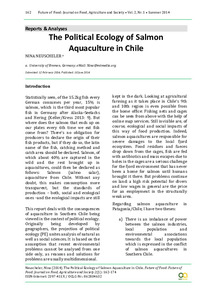| dc.date.accessioned | 2014-06-26T13:29:46Z | |
| dc.date.available | 2014-06-26T13:29:46Z | |
| dc.date.issued | 2014-06-10 | |
| dc.identifier.issn | 2197-411X | |
| dc.identifier.uri | urn:nbn:de:hebis:34-2014062645650 | |
| dc.identifier.uri | http://hdl.handle.net/123456789/2014062645650 | |
| dc.language.iso | ger | |
| dc.publisher | Department of Organic Food Quality and Food Culture at the University of Kassel, Germany and Federation of German Scientists (VDW) | eng |
| dc.rights | Urheberrechtlich geschützt | |
| dc.rights.uri | https://rightsstatements.org/page/InC/1.0/ | |
| dc.subject.ddc | 630 | |
| dc.title | The Political Ecology of Salmon Aquaculture in Chile | eng |
| dc.type | Aufsatz | |
| dcterms.abstract | Every German consumes per year, 15% is salmon, which is the third most popular fish in Germany after Alaska-Seelachs and Hering (Keller/Kress 2013: 9). But where does the salmon that ends up on our plates every 6th time we eat fish come from? There's no obligation for producers to declare the origin of their fish products, but if they do so, the latin name of the fish, catching method and catch area should be declared. Salmon, of which about 40% are captured in the wild and the rest brought up in aquacultures, could then be declared as follows: Salmon (salmo salar), aquaculture from Chile. Without any doubt, this makes consumption more transparent, but the standards of production – both, social and ecological ones – and the ecological impacts are still kept in the dark. | eng |
| dcterms.accessRights | open access | |
| dcterms.bibliographicCitation | In: Future of Food: Journal on Food, Agriculture and Society. Witzenhausen : University of Kassel, Department of Organic Food Quality and Food Culture. - Vol. 2, No. 1 (2014), S. 162-174 | |
| dcterms.creator | Neuscheler, Nina | |

